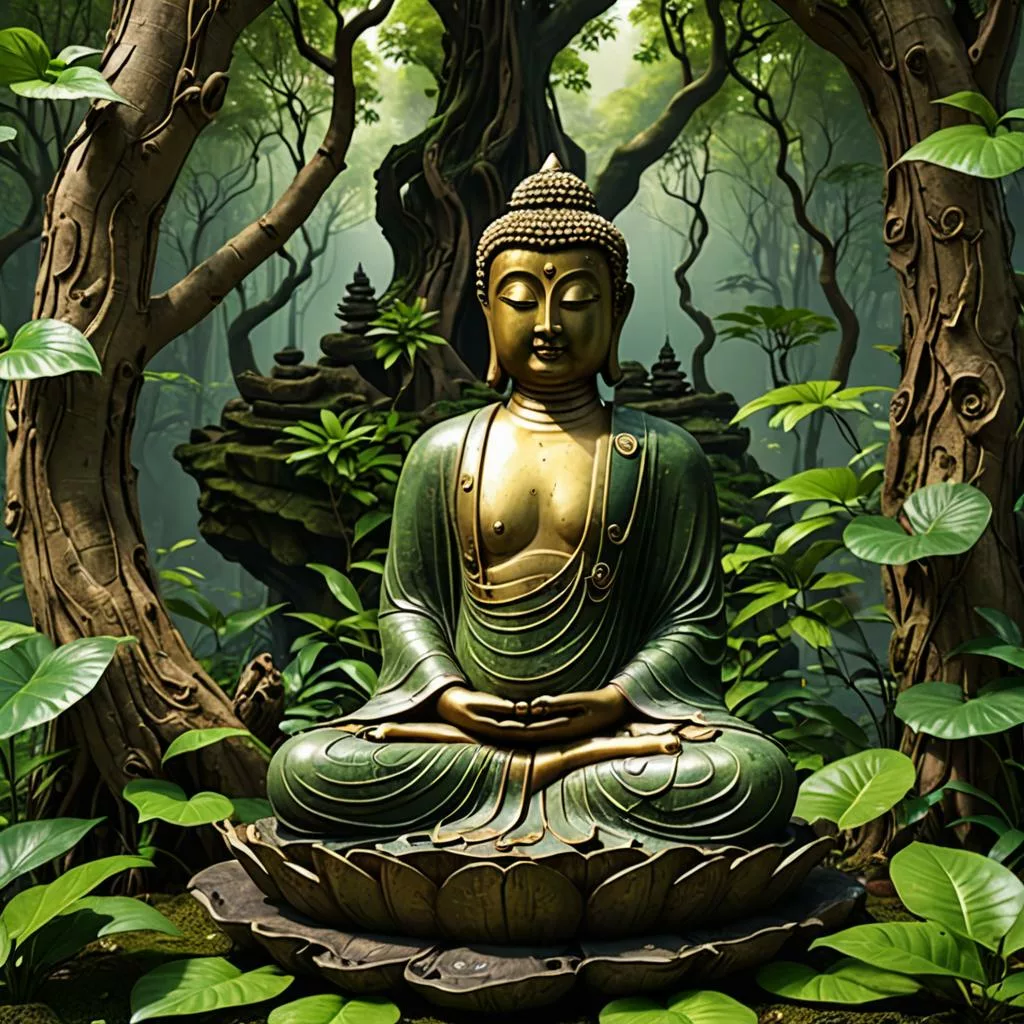
Buddha Nature is the central concept of the 3rd Turning of the Wheel of Dharma by the Buddha. It claims that all beings have a luminous, enlightened essence that can be developed.
It is important to realize the Buddha Nature is also empty. What that means is a debate. I subscribe to the Shentong, empty of other view. Some claim that we Shentonpas are heretics and that the absolute nature is Rangton, empty of itself. It has no essence. See this post on the 5 stages of meditation on emptiness for a deep dive on the issue.
Secrets of Meditation for Anxiety
Like millions of people, you may have suffered from anxiety for years. Meditation, yoga, peaceful music – it never works. It takes too long, and it’s not stable. Why? Because peace is treated as a cause for freedom, but it’s not – it’s the result. The cause to free yourself from anxiety is completely different.
Click now to Overcome Anxiety for good.
Table of Contents
Buddha Nature Summary Table
| Property | Description |
|---|---|
| Central Node | Buddha Nature (Tathagata-garbha) |
| Definition | A concept in Mahayana Buddhism suggesting that all sentient beings inherently possess the potential to achieve enlightenment. |
| Origin | Mahayana Buddhist texts (specifically, the Tathagatagarbha Sutras) |
| Core Tenets | * All beings have Buddha nature, a pure and luminous essence. * This essence is obscured by煩惱 (fannao – mental defilements) such as greed, hatred, and delusion. * Through spiritual practice, we can remove these defilements and realize our inherent Buddha nature, achieving enlightenment. |
| Related Concepts | * Enlightenment (Bodhi) * Nirvana * Emptiness (Shunyata) * Karma * Rebirth (Samsara) |
| Significance | * Offers a universal path to enlightenment, suggesting everyone has the potential for liberation. * Provides a foundation for Mahayana practices that emphasize helping all beings achieve enlightenment. |
| Contrasting View | Theravada Buddhism generally does not subscribe to the concept of Buddha-nature, emphasizing the path of personal effort and practice for achieving enlightenment. |
How to meditate like a yogi
and enter profound samadhi
Buddha Nature, or tatagathagharba, is the central concept in the third turning of the wheel of dharma by the Buddha. The idea is that we are perfect in our basic nature, just as we are. We only need to do the work to uncover that.
Buddha Nature: A Core Tenet of Mahayana Buddhism
The concept of enlightenment, achieving a state of perfect wisdom and freedom from suffering, is a central goal in Buddhism. Mahayana Buddhism, a distinct branch of Buddhist thought, offers a unique perspective on this path. At its heart lies the concept of Buddha Nature, a fascinating theory that has captivated scholars and practitioners for centuries. This post will explore the core tenets of Buddha Nature, its significance within Mahayana Buddhism, and its role in the journey towards enlightenment.
What is Buddha Nature?
The concept of Buddha Nature, literally translated from Sanskrit as “Tathagatagarbha” (Tathagatha – “Thus-Gone One,” Garbha – “womb” or “embryo”), is a foundational principle in Mahayana Buddhism. It proposes a profound truth: all sentient beings inherently possess the potential for enlightenment. Imagine a tiny seed holding within it the potential to blossom into a magnificent flower. In the same way, Buddha Nature is seen as the inherent potential for complete awakening and liberation from suffering that resides within each of us.
This core tenet challenges the idea that enlightenment is reserved for a select few. Instead, Mahayana Buddhism suggests that Buddha Nature is like an innate spark waiting to be ignited, a seed waiting to sprout. It’s the very essence of our being, obscured by layers of negativity and confusion, but nonetheless present and waiting to be realized.



The Seed of Buddhahood Within
Just like a tiny seed holds the potential to transform into a vibrant flower, Buddha Nature resides within us all, waiting to blossom into enlightenment. This inherent potential isn’t readily apparent, however. Imagine the seed buried beneath layers of soil and debris. Similarly, our Buddha Nature can be obscured by mental defilements, known in Chinese as “fannao” (煩惱). These defilements, like greed, hatred, and delusion, act as obstacles, clouding our true nature and hindering our progress towards awakening.
The Path to Uncovering Buddha Nature
The good news is that Buddha Nature isn’t permanently hidden. Through dedicated spiritual practice, we can gradually clear away these mental defilements and cultivate the qualities that allow our Buddha Nature to shine through. This journey is akin to nurturing the seed – providing it with sunlight, water, and care. Practices like meditation, ethical conduct, and cultivating compassion help us loosen the grip of negativity and awaken the wisdom and potential that lie dormant within.
It’s important to remember that the path to enlightenment is influenced by karma, the law of cause and effect. The positive actions we take in this lifetime and previous ones can create fertile ground for Buddha Nature to flourish, while negative actions can create obstacles. Additionally, the concept of rebirth plays a role. Mahayana Buddhism generally views enlightenment as a gradual process that may unfold over multiple lifetimes. With each lifetime, we can refine our practice, clear away more negativity, and move closer to realizing our inherent Buddha Nature.
The Significance of Buddha Nature:
The concept of Buddha Nature offers a powerful message of hope and inclusivity. It suggests that enlightenment isn’t reserved for a chosen few or those with exceptional abilities. Instead, it posits a universal path – the potential for awakening resides within every single being. This inherent potential transcends social status, background, or past mistakes. Just as every seed has the capacity to blossom, regardless of its initial location, so too does every being have the potential to cultivate their Buddha Nature and achieve liberation.
This universality is particularly significant within Mahayana Buddhism, which emphasizes the Bodhisattva ideal – the path of a compassionate being who strives to help all beings achieve enlightenment. The understanding that all beings possess Buddha Nature fuels the Bodhisattva’s motivation. It becomes a recognition of the inherent potential for awakening in everyone, not just oneself. This fosters a deep sense of compassion and a commitment to creating the conditions for all beings to realize their own Buddha Nature.
Contrasting Views:
It’s worth noting that Theravada Buddhism, another major branch of Buddhism, generally has a different perspective on the path to enlightenment. Theravada emphasizes individual effort and practice, focusing on achieving liberation (Arhatship) in this lifetime. While the concept of inherent potential exists in Theravada teachings, it’s not central to the path in the same way it is in Mahayana Buddhism.
Conclusion: the Potential beyond limit
The concept of Buddha Nature offers a profound perspective on our inherent potential for enlightenment. It’s a reminder that the seeds of awakening lie dormant within each of us, waiting to be cultivated. By understanding how Buddha Nature can be obscured by negativity and how spiritual practice can help us clear the path, we embark on a transformative journey.
This exploration of Buddha Nature is just the beginning. Mahayana Buddhist texts and practices offer a wealth of knowledge and guidance for those seeking to nurture their inherent potential. Whether you’re a seasoned practitioner or simply curious about the possibilities for awakening within yourself, delving deeper into Buddha Nature can be a powerful step on the path towards a more compassionate and enlightened existence.

May all beings be happy
May all beings be peaceful
May all beings be safe
May all beings awaken to the light of their true nature
May all beings be free







